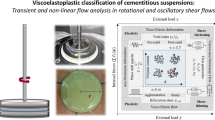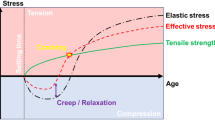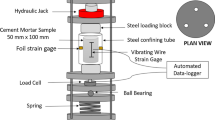Abstract
Analytical approaches for modeling aging viscoelastic behavior of concrete include the time–shift approach (analogous to time-temperature superposition), the solidification theory, and the dissolution–precipitation approach. The aging viscoelastic properties of concrete are generally attributed solely to the cement paste phase since the aggregates are typically linear elastic. In this study, the aging viscoelastic behavior of four different cement pastes has been measured and modeled according to both the time–shift approach and the solidification theory. The inability of each individual model to fully characterize the aging viscoelastic response of the materials provides insight into the mechanisms for aging of the viscoelastic properties of cement paste and concrete. A model that considers aging due to solidification in combination with inherent aging of the cement paste gel (modeled using the time–shift approach) more accurately predicted the aging viscoelastic behavior of portland cement paste than either the solidification or time–shift approaches independently. The results provide evidence that solidification and other intrinsic gel aging mechanisms are concurrently active in the aging process of cementitious materials.
Similar content being viewed by others
References
Acker, P.: Micromechanical analysis of creep and shrinkage mechanisms. In: ConCreep 6. Elsevier, MIT (2001)
Bazant, Z.P.: Viscoelasticity of solidifying porous material–concrete. ASCE J. Eng. Mech. Div. 103(EM6), 1049–1067 (1977)
Bazant, Z.P.: Thermodynamics of solidifying or melting viscoelastic material. ASCE J. Eng. Mech. Div. 105(6), 933–952 (1979)
Bazant, Z.P., Prasannan, S.: Solidification theory for concrete creep. II: Verification and application. J. Eng. Mech., ASCE 115(8), 1704–1725 (1989)
Bazant, Z.P., Baweja, S., Ulm, F.-J.: Microprestress-solidification theory for concrete creep. I: aging and drying effects. J. Eng. Mech. 123(11), 1188–1194 (1997)
Bentur, A., Milestone, N.B., Young, J.F.: Creep and drying shrinkage of calcium silicate pastes. II: Induced microstructural and chemical changes. Cem. Concr. Res. 8(6), 721–732 (1978)
Boumiz, A., Vernet, C., Cohen Tenoudji, F.: Mechanical properties of cement pastes and mortars at early ages. Adv. Cem. Based Mater. 3(3–4), 94–106 (1996)
Carol, I., Bazant, Z.P.: Viscoelasticity with aging caused by solidification of nonaging constituent. J. Eng. Mech. 119(11), 2252–2259 (1993)
Jennings, H.M.: Colloid model of C–S–H and implications to the problem of creep and shrinkage. Mater. Struct. 37(265), 59–70 (2004)
Jennings, H.M., Thomas, J.J.: A colloidal interpretation of chemical aging of the C–S–H gel and its effects on the properties of cement paste. Cem. Concr. Res. 36(1), 30–38 (2006)
Morland, L.W., Lee, E.H.: Stress analysis for linear viscoelastic materials with temperature variation. Soc. Rheol.–Trans. 4, 233–263 (1960)
Neville, A.M.: Properties of Concrete. Pearson Education Ltd., Essex (1995)
Neville, A.M., Dilger, W.: Creep of Concrete: Plain, Reinforced, Prestressed. North-Holland, Amsterdam (1970)
Read, W.T.: Stress analysis for compressible viscoelastic materials. J. Appl. Phys. 21, 671–674 (1950)
Schwarzl, F., Staverman, A.J.: Time-temperature dependence of linear viscoelastic behavior. J. Appl. Phys. 23, 838–843 (1952)
Struik, L.C.E.: Physical Aging in Amorphous Polymers and Other Materials. Elsevier, New York (1978)
Suter, M., Benipal, G.S.: Time-dependent behaviour of reacting concrete I: Mechanism and theory. Mech. Time-Depend. Mater. 10(1), 51–62 (2006a)
Suter, M., Benipal, G.S.: Time-dependent behaviour of reacting concrete II: Applications and discussion. Mech. Time-Depend. Mater. 10(1), 63–81 (2006b)
Vichit-Vadakan, W., Scherer, G.W.: Measuring permeability and stress relaxation of young cement paste by beam bending. Cem. Concr. Res. 33(12), 1925–1932 (2003)
Author information
Authors and Affiliations
Corresponding author
Rights and permissions
About this article
Cite this article
Grasley, Z.C., Lange, D.A. Constitutive modeling of the aging viscoelastic properties of portland cement paste. Mech Time-Depend Mater 11, 175–198 (2007). https://doi.org/10.1007/s11043-007-9043-4
Received:
Accepted:
Published:
Issue Date:
DOI: https://doi.org/10.1007/s11043-007-9043-4




